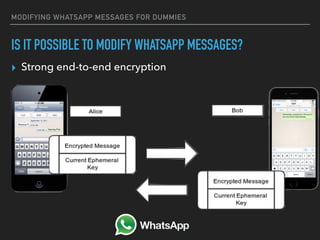The realm of encrypted messaging is akin to a grand, impenetrable fortress, where messages are securely locked away from prying eyes. Within this sophisticated digital citadel, the question arises: can one modify encrypted messages without breaching the sanctity of the cryptographic code? To delve into this inquiry is to navigate the labyrinth of encryption—a world where mathematical elegance collides with the primal instinct to manipulate information.
Encryption serves the dual purpose of confidentiality and integrity. Messages, once incorporated into this cryptographic edifice, are safeguarded against unauthorized access. However, the very attributes that ensure their security also complicate the prospect of modification. When a message is encrypted, it is transformed into a format that is unintelligible to anyone lacking the appropriate key. This transformation, reliant on intricate algorithms, creates what can be perceived as a digital chrysalis, concealing its contents from the outside world.
To understand the feasibility of modifying such messages, we must first contemplate the fabric of cryptographic principles. The architecture of most encryption schemes rests on asymmetric or symmetric keys. Asymmetric encryption utilizes a pair of keys, where one key encrypts the message and the other decrypts it—a somewhat majestic waltz of security. Symmetric encryption, on the other hand, employs a single key for both encryption and decryption, forging a more straightforward yet equally potent shield.
Imagine, if you will, the encrypted message as a perfectly cooked soufflé—delicate, seemingly unalterable, and requiring precise conditions to achieve its intended form. To modify the contents of this soufflé, one must introduce an allowance for change without compromising its overall integrity. Herein lies the crux of the conundrum: the moment one attempts to alter even a single component within the encrypted cipher, one risks precipitating an avalanche of unpredictable consequences.
The cryptographic principles of hashing play a pivotal role here. A hash function takes an input and generates a fixed-size string of characters, which serves as a fingerprint for the original message. Any modification, no matter how minute, will render the hash—akin to a lock—entirely different. Thus, the integrity of the original message is flagged as compromised. Attempts to tweak this message without breaking the encryption invariably lead to incongruity, resulting in a loss of the precious key necessary to access the data.
Furthermore, let us examine the ramifications of message authentication codes (MACs) and digital signatures. These cryptographic tools function as veritable watchdogs, ensuring that any alteration to a message is caught. When a message is sent, it is accompanied by a MAC or digital signature that validates its authenticity. The moment a rogue entity endeavors to modify the payload, this validation cascade collapses, triggering an alert and barring access to the original message.
One might wonder if it is feasible to alter the metadata of an encrypted message. However, this approach does not yield a viable path toward actual modification. The cryptographic sanctity is maintained in such a way that even metadata alterations do not escape the vigilant eye of modern cryptographic protocols. The fortress of encryption is structured not merely around the data itself but around the very essence of its transmission, making holistic alteration an arduous endeavor.
Moreover, consider the implications of social engineering as a form of indirect alteration. In this context, manipulation is not executed through the cryptographic layer directly, but rather through the behavior and responses of the individuals involved. Social engineering, a technique as old as time, leverages psychology to elicit desired actions, thereby modifying the outcome of communications without necessitating technical alterations to the encrypted messages themselves. This approach highlights the vulnerability of human actors against the backdrop of brilliantly designed cryptography.
Despite the formidable barriers to altering encrypted messages, the landscape of cryptography is not static. Researchers continuously explore novel methodologies and vulnerabilities, seeking ways to enhance both encryption strength and interaction. Advances in quantum computing and artificial intelligence present intriguing developments that could one day enable unprecedented levels of message manipulation. However, such prospects remain firmly within the domain of speculative rhetoric and should be approached with tempered skepticism.
In summary, the desire to modify encrypted messages without breaching the cryptographic code is both a tantalizing enigma and a complex puzzle. The intricate balance between confidentiality, integrity, and availability renders direct modification prohibitively challenging. Like a well-crafted illusion, once a message enters the cryptographic realm, it becomes elusive, often escaping the grasp of those wishing to tamper with it. As technology evolves, so too will the paradigms of data integrity and manipulation—leaving us to ponder the essence of trust in this ever-shifting landscape.









Leave a Comment